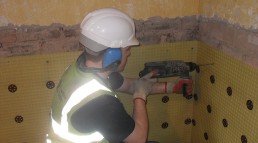Damp causes numerous problems for properties, especially if left untreated. From damage to decoration to mould and even rot damage, it is essential to treat damp as soon as it arises. At Richardson & Starling, we provide property surveys and damp proof injections to resolve related issues. After surveying your property and determining the extent of the damp we can advise you on the best course of action to take.
Most cases of rising damp require a simple course of damp proof injection rather than extensive work. We will outline in this article what damp proof injection is and how it works.
What is Damp Proof Injection?
Damp proof injection is often the most effective treatment for rising damp. Most houses and all new builds will have a damp proof course, which consists of a mortar course with a slate, bitumen or plastic sheeting damp proof course built into the wall. However, over time older damp proof course can deteriorate, become damaged or bridged, causing rising damp in the walls. The capillary action within the wall can bring moisture from the ground and the damp can continue to rise to a hight of around one metre from the ground level unless it is treated. In this instance, a damp proof course injection is usually the most cost-efficient and effective treatment.
The process involved with damp proof injection starts with a survey that is conducted by our experienced surveyors. They will determine the extent of the rising damp, any timbers that could be affected by dry or wet rot and where the treatment needs to be applied. This type of damp proof course injection treatment needs to be at a height of no less than 150 mm from the ground level at base of the wall.

Once the area of damp has been identified, holes are drilled into the walls to a pattern and depth that is determined by the thickness and construction of the wall. The silicone-based damp proof cream is then injected and this quickly diffuses into the brickwork where it forms a moisture repellent damp proof course.
This chemical barrier is designed to stop the capillary rise of water up the wall by forming a barrier throughout the length and width of the wall.
Our damp proof injections are covered by our 30-year guarantee as they provide long-lasting protection from rising damp for your property.
How Do Damp Proofing Creams Work?
Damp proof injection creams are formulated to penetrate deep inside the building material. They are designed to work best on brick or stone walled buildings to treat rising damp.
The active ingredient within damp proofing creams is silane. This ingredient is absorbed into walls when injected into the drilled holes, and the chemical cream lines the capillaries before curing to create a water-repellent barrier.
What is a Damp Proof Course?
A damp proof course (DPC) is either a barrier installed during the initial construction of the property or is a chemical DPC injection designed to treat the ingress of damp from the ground affecting the property.
The general installation of a Damp Proof Course in property was implemented in the early 1900’s. This has become a requirement for all buildings to have a damp proof course made up of a mortar course with a damp proof material built into it such as slate, bitumen or plastic sheet. The damp proof course is formed in a mortar course not less than 150 mm above ground level.

Over time the DPC can become damaged, deteriorate or bridged causing rising damp to affect the property. If left untreated, damp can cause wet or dry rot fungal attack to germinate on timbers which could cause serious structural damage to your property.
Chemical damp proofing is a remedial chemical treatment injected into the walls to treat rising damp. It is applied through specifically drilled holes to the base of the walls suffering from the effects of rising damp. The silicone-based chemical lines the holes and pores within the brickwork to form a water-repellent barrier along that stretch of masonry.
Damp Proof Treatment
Injection damp proof treatment is quick and effective to apply to properties. Our specialist technicians will prepare the area that requires the work, both internally and externally (if required). This preparatory work may involve removing fixtures and fittings such as skirting boards and radiators and remove salt affected plaster.
Plaster affected by rising damp will be contaminated with hygroscopic salts from the ground, meaning that it could potentially attract moisture from the air even if the damp proof treatment is applied.
The treatment involves drilling holes into the brickwork or stonework, through which the cream is injected. The 12 mm holes are drilled horizontally into the wall mortar joint to nearly the full thickness of the wall. The chemical damp proof course is then injected into the drill holes, where the active ingredient, silane, reacts with the damp to form a water-repellent barrier. The injected chemicals penetrate deep in the walls before curing.
After the work has been completed, our specialist team will re-plaster the area with a renovating plaster or cover the treated area with a damp proofing membrane to ensure any residual salts in the brickwork do not affect the new plaster.
Damp Proofing Survey
If you notice any damp in your property, our experienced damp specialists can survey the building to identify the cause of the damp and provide the most appropriate specification for repair.
It is important that you only employ the services of a fully qualified remedial surveyor. An incorrect diagnosis could cause further damage to your property as the issue is left unresolved. If damp is left untreated it can cause serious structural damage to your property as structural timbers affected by damp can start to rot.
All PCA approved damp surveyors, such as our own specialist team at Richardson & Starling are qualified to CSRT (Certified Surveyor in Remedial Damp Treatment) level.